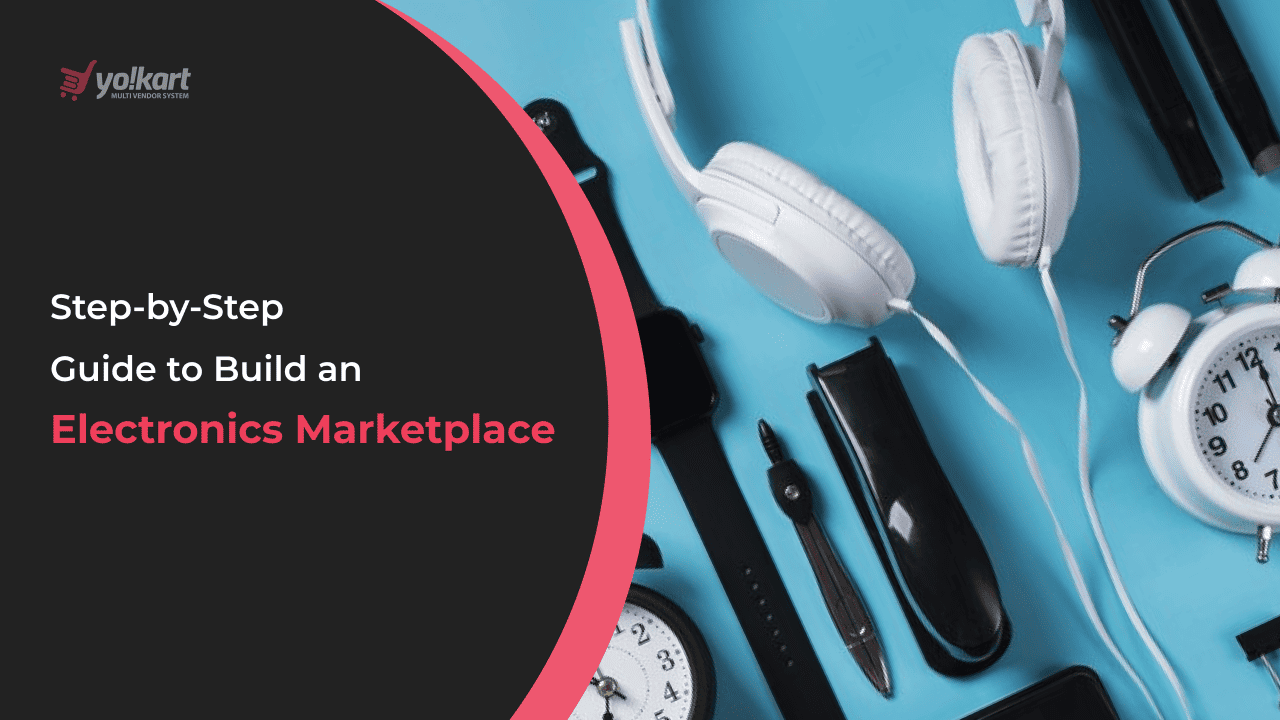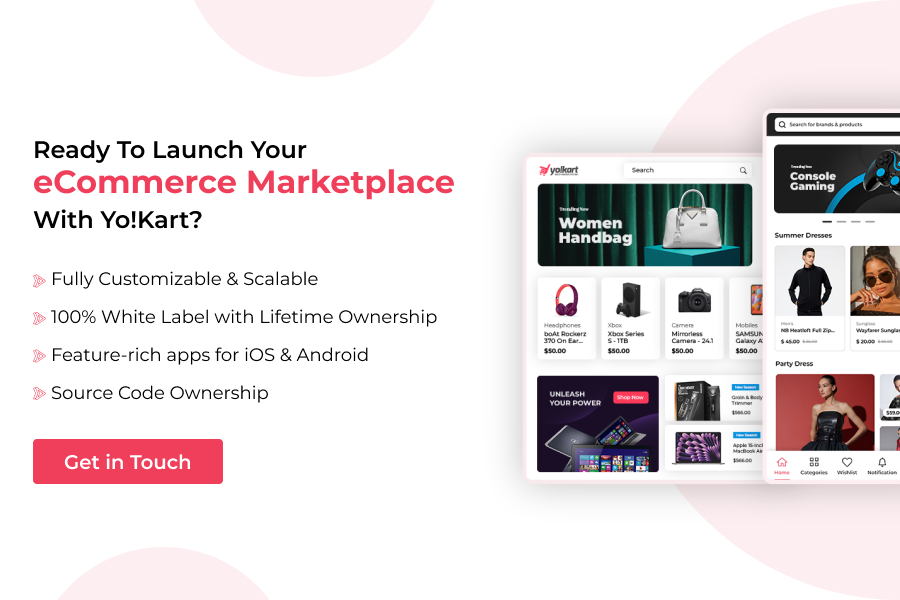The electronics industry is at the heart of global innovation, but traditional buying and selling channels often struggle to keep pace with demand, supply chain complexities, and evolving customer expectations. This is where a well-structured electronics marketplace bridges the gaps in the industry—streamlining procurement, expanding market reach, and driving efficiency for buyers and sellers alike.
With the global market for eCommerce electronics projected to reach $810.1 billion by 2030, the opportunity to build an electronics marketplace has never been more significant. But how do you build an eCommerce electronics marketplace that stands out in this competitive space?
This guide provides a step-by-step approach to creating a scalable, secure, and user-centric platform. Whether you’re a distributor, manufacturer, or entrepreneur looking to build an eCommerce marketplace for electronics, this roadmap will equip you with the strategies and insights needed to establish a thriving digital hub for electronic components, devices, and solutions.
Table of Contents
- Understanding the Market for Electronics and Gadgets Online
- Popular Electronics Marketplaces Worldwide
- How Does an Electronics Marketplace Work?
- Diverse Revenue Strategies of an Electronics Marketplace
- Steps to Build an Electronics Marketplace
- How Does Yo!Kart Help to Build an Electronics Marketplace?
- Conclusion
- FAQs
Understanding the Market for Electronics and Gadgets Online
The global market for electronics and gadgets is a dynamic and highly competitive industry, driven by continuous technological advancements and evolving consumer preferences. With the increasing reliance on digital devices, the demand for smartphones, laptops, smart home appliances, wearables, and gaming accessories has surged. Businesses looking to capitalize on this market must understand key trends, customer behaviors, and the competitive landscape to position their electronics marketplace effectively.
Key Market Trends and Consumer Insights
1. Rise of Online Shopping: Consumers increasingly prefer purchasing electronics online due to competitive pricing, product variety, and convenience. According to industry reports, the global consumer electronics eCommerce marketplace is expected to grow at a steady pace and is projected to reach $1,467.94 billion by 2032, driven by higher internet penetration and digital transformation.
2. Influence of Product Reviews and Comparisons: Informed purchasing decisions are crucial in this sector. Customers rely heavily on product reviews, ratings, and side-by-side comparisons before making a purchase. An electronics marketplace must integrate these features to enhance customer confidence and trust.
3. Cross-border eCommerce Expansion: International shipping and global trade have opened up opportunities for businesses to source and sell electronics across borders. An electronics marketplace that supports multi-currency transactions, localized content, and region-specific logistics can gain a competitive edge.
4. Adoption of AI and Personalization: AI-driven product recommendations and personalized shopping experiences are becoming standard in electronics marketplaces. Businesses leveraging AI can enhance user engagement, improve customer satisfaction, and boost sales conversions.
Opportunities for B2B and B2C Segments to Build an Electronics Marketplace
A well-structured electronics marketplace can cater to both B2B (business-to-business) and B2C (business-to-consumer) segments, each offering unique opportunities for growth, revenue generation, and market expansion. Understanding the distinct needs of these segments helps in designing a scalable eCommerce electronics marketplace that meets diverse customer expectations.
Below are some opportunities mentioned to build an eCommerce marketplace for electronics:
1. B2C Opportunities: Businesses can target tech-savvy consumers looking for the latest gadgets, gaming accessories, and smart home devices. Personalization, competitive pricing, and customer support play a critical role in retaining customers in an eCommerce marketplace for electronics.
2. B2B Opportunities: Many businesses purchase bulk electronics for resale, corporate use, or office setups. An eCommerce electronics marketplace software that offers bulk pricing, vendor management, and wholesale fulfillment options can cater to this segment effectively.
Popular Electronics Marketplaces Worldwide
The global electronics eCommerce sector is dominated by well-established marketplaces that cater to various consumer and business needs. Understanding these platforms provides insights into best practices, revenue strategies, and customer expectations:
1. Amazon: Amazon is the world’s largest online marketplace, offering a vast selection of electronics, including smartphones, laptops, home appliances, and accessories. With its Fulfilled by Amazon (FBA) model, sellers can store their products in Amazon’s warehouses, benefiting from logistics, customer service, and Prime shipping.
2. eBay: eBay operates as both an auction-style and fixed-price marketplace, enabling businesses to sell new and refurbished electronics to a global audience. Its strong focus on consumer-to-consumer (C2C) and business-to-consumer (B2C) transactions makes it a preferred platform for diverse product offerings.
3. Best Buy: Best Buy extends beyond its physical stores by allowing third-party vendors to sell electronics on its marketplace. It primarily targets North American consumers and provides seamless integration for brands and retailers looking to reach a tech-savvy audience.
4. Newegg: Newegg is a specialized marketplace for electronics, catering primarily to gaming, computer hardware, and IT professionals. It provides value-added services like fulfillment, advertising, and logistics to sellers, enhancing their eCommerce operations.
5. Alibaba & AliExpress: Alibaba is a global B2B marketplace where manufacturers and wholesalers sell electronics in bulk. AliExpress, its B2C counterpart, allows businesses to sell directly to consumers at competitive prices, making it a go-to platform for international trade.
Launch an eCommerce electronics marketplace like Amazon or Newegg
How Does an Electronics Marketplace Work?
An electronics marketplace serves as an intermediary platform where multiple vendors list, sell, and manage electronic products while buyers explore, compare, and purchase them seamlessly. Unlike single-brand eCommerce stores, a marketplace aggregates offerings from different sellers, fostering competitive pricing and extensive product variety.
Here’s how an electronics marketplace works:
- Vendors register themselves on the platform by submitting required documents and list products with detailed descriptions and clear pictures.
- Customers browse electronics, compare products, and add items to their carts.
- Orders are placed, and payments are processed via the selected payment method.
- Vendors receive order notifications, pack products, and arrange for shipping.
- Orders are shipped using marketplace-approved logistics or vendor-managed delivery.
- Customers receive tracking updates throughout the process.
- Returns & refunds are processed once the order is received based on marketplace policies if requested.
- Vendors receive payouts after deducting platform commission and fees.
Diverse Revenue Strategies of an Electronics Marketplace
A successful electronics marketplace relies on multiple revenue streams to sustain profitability and long-term growth. Below are the most effective monetization strategies:
1. Commission-Based Model: This is the most common revenue strategy, where the marketplace charges a commission on each sale made by sellers.
2. Subscription Plans for Sellers: Marketplaces can offer tiered subscription plans for sellers, granting them access to premium features such as enhanced product visibility, advanced analytics, and priority support.
3. Featured Listings: Sellers can pay for sponsored listings to gain better visibility in search results and category pages.
4. Ad Placements: Third-party brands may pay for banner advertisements, providing an extra revenue source.
5. Value-Added Services: Additional revenue can be generated by offering services like extended warranties, repair services, and product insurance.
By implementing a mix of these strategies, an electronics marketplace can create multiple revenue streams, ensuring steady growth and profitability.
Steps to Build an Electronics Marketplace
1. Comprehensive Market Research:
Before launching an electronics marketplace, conducting thorough market research is crucial. Analyze the demand for electronic products, assess industry trends, and study customer preferences. Competitor analysis is equally important to identify their strengths, weaknesses, and unique selling propositions.
This research will help you understand potential challenges, target the right audience, and define your marketplace’s competitive edge.
2. Identify Your Requirements:
After gathering insights from market research, define your specific business requirements. Determine your business model (B2B, B2C, or C2C), niche categories (smartphones, home appliances, wearables, etc.), and operational needs such as inventory management, payment processing, and logistics integration. Additionally, decide whether your platform will support third-party sellers or operate on a direct-to-consumer basis.
3. List Down Key Features to Build an Electronics Marketplace
To ensure smooth operations and an optimal user experience, an electronics marketplace must include essential features. These may include:
- User-friendly Interface: Responsive and intuitive design for easy navigation.
- Advanced Search & Filters: Category-wise product search, specifications-based filtering, and price comparisons.
- Secure Payment Gateways: Multiple payment options with encryption and fraud detection.
- Vendor Management System: Tools for sellers to manage listings, track orders, and analyze sales.
- Customer Support & Reviews: Chatbots, FAQs, and customer feedback sections for enhanced trust and engagement.
- Multi-language & Multi-currency Support: Essential for global reach.
- Mobile Compatibility: A mobile-friendly interface or dedicated app for seamless transactions.
Additionally, for B2B marketplaces, bulk order functionality and RFQ (Request for Quotation) capabilities can be advantageous. However, you need to prioritize features based on business objectives and user needs to build an electronics marketplace that actually thrives in the market.
4. Choose Between Development Approaches:
The development approach significantly impacts cost, time-to-market, and customization possibilities to build an eCommerce electronics marketplace. Businesses can opt for:
- Custom Development: This approach offers high flexibility and complete control over design and features. However, it requires substantial investment and longer development time. Custom development is ideal for enterprises seeking a tailored solution to meet unique business needs.
- Readymade Software: eCommerce marketplace software solutions provide a cost-effective and quicker way to build an eCommerce electronics marketplace. These solutions come with pre-built features, scalability options, and easy third-party integrations, making them ideal for startups and growing businesses looking for a quick go-to-market strategy.
Build an Electronics Marketplace with The Best-in-Class Software
5. Launch and Market:
Once your eCommerce electronics marketplace is developed and thoroughly tested, launch it with a robust marketing strategy. Utilize digital marketing channels such as SEO, PPC, content marketing, and social media advertising to attract sellers and buyers. Build strategic partnerships with electronics brands and suppliers to establish credibility.
How Does Yo!Kart Help to Build an Electronics Marketplace?
Building an electronics marketplace that holds a strong market presence requires a robust, scalable, and feature-rich eCommerce software solution tailored to meet the industry’s dynamic demands. Yo!Kart is a leading eCommerce marketplace software designed to empower entrepreneurs with a comprehensive solution to build an electronics marketplace with ease.
Whether you are launching a B2B, B2C, or hybrid platform, Yo!Kart provides tailored features to accommodate diverse business models. The software supports high-volume transactions, enabling seamless scalability as your marketplace grows. Here are some of the benefits of choosing Yo!Kart over other solutions:
- 100% white-label solution for unique business branding.
- Lifetime license for one-time payment without any recurring charges.
- Self-hosted solution with flexibility over hosting.
- Fully scalable and customizable solution that caters to specific business needs.
- 20+ payment gateways, providing flexibility for global transactions.
- Designed with an SEO-friendly structure and responsive design.
- Provides mobile-ready solutions to enhance customer engagement.
- Ensures top-tier security with GDPR compliance for data protection.
- Eliminates high development costs and long timelines.
- Complementary post-launch support for 1 year.
Apart from this, Yo!Kart has powered several successful eCommerce marketplaces across the globe. Some notable businesses using Yo!Kart include:
- Voyij – Travel Activities & Shopping Platform
- Watersorted -Transforming Water Procurement in New Zealand
- Anyflexo – Flexographic Printing B2B Marketplace
- Regake – Global Digital Products Marketplace for Video Games
For more details on Yo!Kart’s robust clientele, kindly check out the clients’ page.
Secure a Personalized Demo to Explore the Vast Capabilities of Yo!Kart
Conclusion
Influenced by innovation and shifting consumer demands, the electronics marketplace landscape is evolving rapidly. However, to succeed in this competitive space, businesses must adopt a strategic approach—blending market insights, cutting-edge technology, and a user-centric experience. A robust ecommerce electronics marketplace software like Yo!Kart simplifies the complexities of marketplace development, equipping businesses with the tools they need to thrive. With built-in features tailored for the electronics industry, Yo!Kart helps enterprises launch quickly, optimize performance, and stay ahead in the digital commerce race.
FAQs
Q 1. What key factors should be considered when you build an electronics marketplace?
Ans. When you build an electronics marketplace, consider factors such as market demand, target audience, competitive landscape, supplier partnerships, and platform scalability. Additionally, focus on security, seamless payment integration, multi-vendor functionality, and an intuitive user experience to ensure long-term success.
Q 2. Which development approach is ideal to build an eCommerce electronics marketplace?
Ans. The best approach to build an eCommerce electronics marketplace depends on your business goals, budget, and time-to-market requirements. However, ready-made eCommerce marketplace software is the ideal choice to build an electronics marketplace due to its cost-effectiveness, faster deployment, and pre-built essential features. Unlike custom development, which requires extensive time and resources, a ready-made solution like Yo!Kart provides a scalable, customizable, and secure platform with built-in multi-vendor functionality, payment integrations, and mobile responsiveness. It allows businesses to launch quickly, adapt to market demands, and focus on growth rather than complex development challenges.
Q 3. How does Yo!Kart stand out from other eCommerce marketplace software solutions for electronics?
Ans. Yo!Kart differentiates itself from other eCommerce marketplace software with its built-in multi-vendor capabilities, white-label flexibility, and extensive features tailored for electronics businesses. It offers advanced vendor management, a scalable architecture, and robust security, ensuring a seamless experience for both administrators and vendors.
Q4. What is the cost of building an eCommerce electronics marketplace with Yo!Kart?
Ans. The cost to build an electronics marketplace with Yo!Kart varies based on the chosen package and any required customizations. Yo!Kart offers multiple pricing models to suit different business needs, ensuring a cost-effective and scalable solution without recurring transaction fees.
For more details on the pricing, kindly click here.




